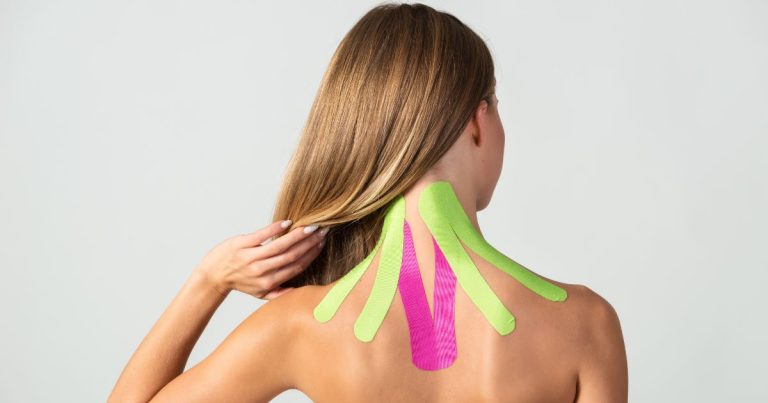Kinesio tape is a common sight on the arms, knees and shoulders of elite athletes, but could it also be beneficial for singers?
Spend an afternoon watching athletics, tennis or rugby, and you’re sure to see at least one competitor (although probably more) wearing Kinesio tape.
Often brightly coloured (purely for aesthetic reasons), Kinesio tape is used to support muscles and reduce joint stress.
As Performance Physiotherapist Genevieve Tawiah explains, “Kinesio tape allows you a bit more movement [than firm tape] but also gives the wearer feedback about how they’re using their body.”
Genevieve, who specialises in vocal physiotherapy, stresses that while useful, taping isn’t a magic cure for injury or postural and movement problems.
“Taping won’t resolve an issue itself, although it might help you develop greater awareness,” she says.
“The taping is to enhance the benefits or understanding of the exercises that we’re doing.”
Using Kinesio tape in the physiotherapy studio
So, when would a physio reach for the Kinesio tape?
“Let’s say a person who’s sat on Zoom all day, leaning forward with no awareness of posture, is getting loads of neck tension around their jaw,” Genevieve says. “I’ve given them exercises, but they can’t pinpoint what it feels like to open their chest.
“In that case, I might Kinesio tape over and around the shoulder or down their back extensor so they can feel the muscles they’re trying to find to open up that position.
“It won’t rigidly hold them there, but they can feel the pull and hopefully do the exercises correctly.
“I might use that to get them familiar [with doing the exercises the right way] and then take it off so they can try and replicate it.”
Could Kinesio Tape Become a Common Sight at Music Gigs?
If it’s good enough for elite sportspeople, should vocalists with injuries follow suit?
There’s very little research on the benefits of taping singers specifically; most studies focus on sportspeople. (Although, Genevieve is currently writing a paper with a colleague on its use in voice management, so keep an eye out for it.)
But given its growing popularity, it’s plausible to imagine that taping will become more visible on the music scene in the future.
However, given singers can feel insecure about broadcasting their voice issues, it’s unlikely that we’ll see taping on the jaw or front of the neck.
“But tape on the back of the neck or back of the shoulder might be useful,” Genevieve says.
Do you need a health professional to apply the tape?
That all depends on the individual and their knowledge of anatomy.
“Sometimes people will come in, and they’ll already have their tape and have found a way [to use it] because they’re in tune with their body,” Genevieve says.
“They’ll know that it doesn’t feel nice when their shoulder is in a certain position, and they’ll have found a way to offload it.
“The interesting thing about Kinesio taping is there’s no one right way to do it so sometimes people can work it out themselves. However, if there is injury pain of some form, it’s always best to get a bit of medical guidance.
“That way, you know you’re taping in the right direction and that it won’t influence other problems.
“Another thing to remember is don’t leave the tape on for too long, as the skin can get irritated.”
Learn more
Check out our interview with Genevieve the Singing Teachers Talk podcast to learn more about:
- How a Performance Physiotherapist helps vocalists.
- A useful body-mapping exercise Genevieve uses with her clients.
Image credit: Canva




